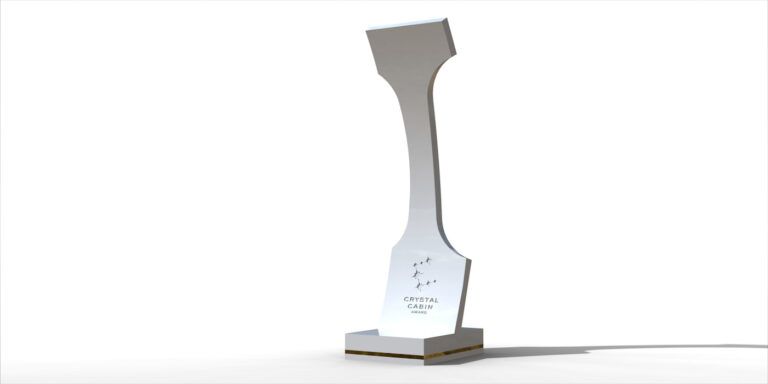The best ideas for the future onboard experience – both short term and longer term – have been decided by a 25-strong panel of aircraft interior experts. This, the 11th year of the awards, an initiative of Hamburg Aviation, was more international and more hotly contested than ever before, with 85 submissions from 21 countries.
Category: Cabin Concepts
Delta triumphed with its new Delta One business class suite, with privacy levels that bring a first class feel to business class travel. The suites will be introduced in Fall 2017 on Delta’s A350 fleet, and each of the 32 Delta One passengers will be accessing their seats – directly from the aisle – via a sliding door. These spaces will be highly private, but for couples flying together, sliding privacy dividers between the center suites will enable more options for a sociable experience.
The suite is a heavily customized version of Thompson Aero Seating’s Vantage XL platform, fettled by the Factorydesign studio in London.
“Everything on the seat was customized,” explains Ryan Graham, a senior designer at Factorydesign, adding that the ability to add doors was driven by the A350’s generous cabin width.
The doors are a star attraction of the suites, but within the space, passengers will enjoy lie-flat beds, 18in HD IFE displays, in-suite ambient lighting, memory foam-enhanced comfort cushions, in-seat USB and power ports, and dedicated stowage compartments for shoes, headphones and laptops.
“Delta is elevating the international business class experience,” states Tim Mapes, senior vice president at Delta. “Added comfort and privacy are important to business travelers, and that drove the design of the all-new Delta One suite.”
Following the A350 debut, the suites will be progressively rolled out on Delta’s B777 fleet.
A battle of titans
Delta One triumphed against stiff competition. Runner-up United Airlines’ Polaris business class has an innovative cabin configuration which offers all-aisle access seats in a density neutral layout, without compromising space or comfort. Polaris was created in cooperation with Acumen, PriestmanGoode, Zodiac Aerospace, Encore, Boltaron and Kydex.
Also in contention for the best cabin category was Bombardier with the cabin for its C Series, the first completely new short and medium-haul airliner for 30 years.
Category: Cabin Systems
Power and data cables are heavy and can lead to ‘cable spaghetti’. Imagine if the power cables could also carry data, reducing complexity and weight, and even allowing a little extra cabin space to be carved out through the reduced volume. This is just what Diehl Aerospace has envisioned with its Power Line Communication concept, and it has proved to be a winning idea.
The notion of ‘free-loading’ data flows (including Ethernet, CAN and ARINC429) using existing power cabling was developed in cooperation with Lucerne University of Applied Sciences and Arts, and in addition to the obvious benefits of saving weight, further potential advantages of the concept include reduced installation time and effort, greater flexibility in cabin layouts, and simpler changes to cabin configurations.
Useful competition
Diehl was up against the Watchdog from Airbus, which addresses the problem of accidental activation of the emergency escape chutes on the ground when crew members open the aircraft doors, by using a sensor that warns whenever there is a movement near the door handle.
Zodiac Aerospace was also in the running with a sensor: the ECOS cabin baggage management system for overhead compartments that sees lights on the lockers indicate free space for cabin baggage, as well as offering a little extra space for cases.
Category: Electronic Systems
The proven Airtime wireless IFE and connectivity portal from Global Eagle triumphed in this category. Currently installed and operational on over 800 aircraft, Airtime enables inflight streaming of live TV, on-demand movies and television shows, games, music, digital publications, flight tracking and destination information to passengers’ personal mobile devices, and passengers can also use the system to connect to high-speed internet.
Global Eagle can offer this content through its own portfolio, and can also work with airline clients to create customizable branded campaigns across the user interface, as well as advertising and sponsored content tailored for passenger demographics and routes.
High-tech competition
Airbus impressed with its radio-based wireless communication (WAIC – Wireless Avionics Intra-Communications) system, whereby smoke detectors, lighting and temperature regulation can be controlled via radio frequency, saving cable weight and complexity.
As a new take on the popular moving map, Lufthansa Technik made it to the finals with its ‘niceview mobile’ product, which offers passengers a way to follow their journey via interactive maps on their personal mobile devices.
Category: Greener Cabin, Health, Safety and Environment
A simple but effective idea, the ReTrolley enables crew to separate waste into recyclables and non- recyclables as it is collected in the aisle, thus increasing an airline’s proportion of recycled waste and improving their ecological credentials. Better still, a simple manual lever compression system enables the volume of the waste to be reduced by up to 30%, saving space in the galley.
The ReTrolley is based on a concept first designed by students at University of São Paulo and later advanced by Airbus Innovations experts. As part of the Airbus BizLab Accelerator program, the concept was validated with airlines last year using a demonstrator.
Clean competition
The worthy runners-up included the GermFalcon from the US-based company of the same name, a device that cleans cabins using ultraviolet C light, which removes bacteria and viruses from seats and other surfaces without the use of chemical agents.
The Revolution Toilet from Zodiac Aerospace is also designed to fight bacteria. A vent built into the rinse ring prevents germ growth underneath the lavatory shroud, with its environmental enhanced by its use of composite and recyclable materials and water- saving features.
Category: Materials & Components
A collaboration between Vanema, Boxmark, Stelia Aerospace and Airbus promises to add seating comfort on long-haul flights and also reduce weight. The product of their expertise is Octaspring, a foam spring that combines the support and comfort of foam with the functionality of a spring, while using less material than a solid foam – making it a claimed one-third lighter than an all-foam cushion.
The foam springs are placed individually within a seat and move in three dimensions for improved weight distribution, pressure relief and comfort. Springs of varying density can be used in the same layer to create targeted zones, which increases comfort and extends the structure’s lifespan. The open spring structure is also claimed to provide eight-times better ventilation than solid foam, for a better night’s sleep.
Stylish ideas
Runners-up in this category were the K-Reflexion Mirror from Krüger Aviation, a plastic mirror with a semi-transparent structure which can display safety announcements, product information and tips for the destination in the onboard lavatory, and Diehl Aircabin’s direct printing method that allows colors and patterns to be added to panels without having to remove them.
Category: Passenger Comfort Hardware
Airlines dream of being able to tailor the cabin for each flight, and the winning Smart Cabin Reconfiguration idea could make it happen. Recaro collaborated with Airbus and seat rail specialist THK on this innovation, which means passengers can benefit from unoccupied seats.
By simply flipping up the rear seats and sliding back the remaining seat rows back, cabin crew can adjust seat pitch based on flight reservation data – all within the turnaround time. The idea is initially intended for the A320.
Quick & easy
Bombardier’s second finalist in the awards was its concept of barrier-free toilets for PRMs on its CRJ range of aircraft. They were facing off with Diehl Comfort Modules, with its bar module – developed in collaboration with Lufthansa Technik – which can be integrated into the galley in just a few simple steps, transforming a functional kitchen space into a bar or a duty-free sales counter.
Category: University
For passengers with limited mobility, independence on board an aircraft is highly desirable. This is made possible with the Smart Onboard Wheelchair, which the passenger can roll over the toilet seat unassisted, aided by a specially shaped seat.
This is an easy innovation to implement across a fleet as no structural changes to the aircraft lavatory are not required. The wheelchair was designed by students of the Hamburg University of Applied Sciences supported by Airbus experts. The project was tested by wheelchair users, whose verdict was ‘easy to handle, stable, and safe’.
Delft double
The Hamburg students triumphed against two finalists from Delft University of Technology. Myseat, developed with a little help from Zodiac Aerospace, is the equivalent of a parking guidance system for passengers, accompanying them all the way from check-in to their seat using Bluetooth technology, reducing passenger stress and helping structure the boarding process.
Meanwhile, the Revitalisation System turns the cabin seating upholstery into a game controller, with body movements controlling the IFE system so a long-haul flight can become a workout. Zodiac Seats US aided the development of this concept.
The awards process
All entries to the competition are examined by the Crystal Cabin Awards Association pre-selection committee to ensure that entries comply with the rules of the awards, and a short-list of the best entries is then created.
The short-listed entries are then evaluated and scored by each judge separately, according to criteria of grade of innovation, operator benefit and passenger benefit. The first-round voting results in a list of top-three finalists for each category. To eliminate any possible conflicts of interest, members of the panel who have any relationship with an entry under evaluation have to abstain from voting.
These top three entries are then presented in person to the judging panel at an evaluation day in Hamburg, with applicants quizzed and all manner of prototypes tried and tested. There follows intense discussion of the entries, a final voting process, and then the winners are decided.
The final steps? A glamorous awards ceremony at the Hotel Atlantic Kempinski, and a display at Aircraft Interiors Expo.
A little support
The Crystal Cabin Awards are sponsored by the Free and Hanseatic City of Hamburg and supported by several partners, including Aircraft Interiors International, Airbus, Aircraft Interiors Expo, Altran, ATR, B/E Aerospace, Boltaron, Boxmark, Diehl, Flight Chic, HAECO Cabin Solutions, Jetliner Cabins, Lufthansa Technik, Recaro and Sekisui SPI.





